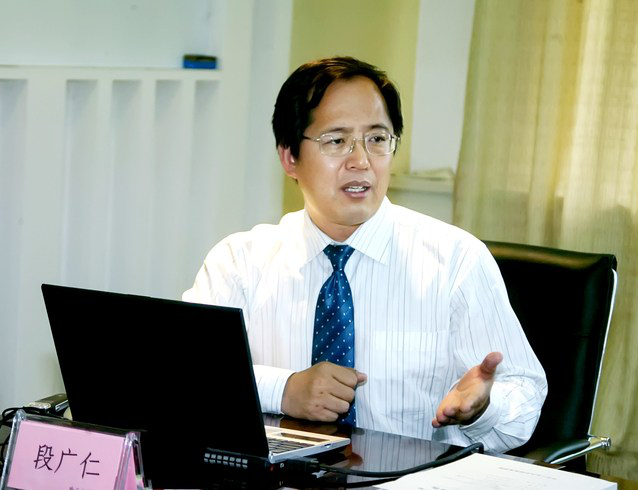Written by: School of Architecture
Translated by: LIU Danyang
Edited by: William Mosteller
Date: 11-22
Newsletter of Harbin University of Technology (comprehensive text/picture)The Chinese academy of sciences and the Chinese academy of engineering have announced the list of academicians co-elected in 2019. Professor Duan Guangren was elected academician of the Chinese Academy of Sciences, and professor Cao Xibin and professor Ma Jun were elected academicians of the Chinese Academy of Engineering. At this point, the number of academicians of our university has increased to 39 (including sharing).
Duan Guangren, male, born in April, 1962, member of the Communist Party of China, member of the Society of Automation of China, IEEE and IET. He has engaged in the research of automatic control theory and application for a long time, and has established a number of parametric general solution formulas of control law to ensure the stability of the system. Furthermore, he has systematically put forward the parametric design theory of the control system through parameter optimization, which has solved the problem of A. Teel input saturation left over for 15 years. The main method is called "Duan method" by international scholars. It has been used in the simulation and experiment of power system, four-rotor aircraft and other practical objects, as well as in the on-orbit application of attitude control law design of China's "Tiantong 1" large antenna satellite. It has made systematic and creative contributions to the parameterized design of control system, and won the second prize of two National Natural Science Awards (both ranked first). He has published 274 SCI papers, 2 monographs in English and 1 book in English. His single Chinese book won two National Book Awards; He presided over the major programs of NSFC and the Innovation Group Program, the Changjiang Scholars Innovation Team Program of the Ministry of Education, and the major national special contract programs. He successively served as an expert in the Innovation Special Zone, an "863" expert, a member of the Academic Committee of the State Key Laboratory of Science and Technology of the Fifth Academy of Aerospace Sciences, and a member of the Information Science Department of the Science and Technology Commission of the Ministry.

Cao Xibin, male, born in February, 1963, is a member of the Communist Party of China, an expert on the overall design of small satellites, a special professor of Yangtze River scholars, and a national model teacher.He graduated from Harbin Institute of Technology in 1991 with a doctorate degree. At present, he is a member of the Evaluation Group of Aerospace Science and Technology Discipline of the Academic Degree Committee of the State Council, the chief scientist of Major Projects of the Innovation Special Zone, the member of the Committee of Experts in the Field of Aerospace, the vice-chairman of the Satellite General Technology Specialty Group, the vice-chairman of the Chinese Society for Space Science, and the vice-president of Harbin Institute of Technology. He also served as "973" technology chief, national "863" experts. He has engaged in the research of basic theory, innovative technology and engineering application of small satellites for a long time, and has made innovative achievements in the integration of small satellites, satellite-rocket integration and flexible platform design, making great contributions to the application of small satellites in the fields of space equipment, commercial remote sensing and deep space exploration. The first completed person won two second-class awards of the National Technological Invention Award and one second-class award of the National Technological Progress Award. Three achievements were selected into the Top Ten Scientific and Technological Progress of Chinese Universities, and two achievements were included in the 2016 White Paper on China's Aerospace Industry. Won the First National Innovation Award; Authorized 67 invention patents and published 2 monographs. He won two second-class awards of the National Technological Invention Award and one second-class award of the National Scientific and Technological Progress Award for his first accomplishment. Three achievements were selected into the Top Ten Scientific and Technological Progress of Chinese Universities, and two achievements were included in the 2016 White Paper on China's Aerospace Industry. He won the first National Innovation Award; authorized 67 invention patents and published 2 monographs.

Ma Jun, male, born in July, 1962, is a memberof the Communist Party of China, professor and doctoral supervisor. He has engaged in the research of water treatment theory and technology for a long time, the theoretical system of pollution removal for ferromanganese oxidizers with different valence was established. The technologies of permanganate pre-oxidation and ferrate pre-oxidation,advanced treatment by ozone catalytic oxidation, enhanced removal of heavy metals based on the characteristics of new ecological micro-interface, nano-composite membrane water treatment and advanced persulfate oxidation were developed.These technologies have been successfully applied to the purification and treatment of polluted source water, the advanced treatment and reuse of sewage, and have played an important role in many major pollution emergency projects. He is a recipient of the National Fund for Distinguished Young Scholars, a special professor of Changjiang Scholars and a fellow of the Royal Society of Chemistry of the United Kingdom. He has been awarded the Young Scientist Award of China, the Achievement Award of Changjiang Scholars (Engineering Science Award), the Sustainable Development Water Award of the Royal Society of Chemistry of the United Kingdom and the Scientific Excellence Honor Award of the American Chemical Society. He won two second-class awards of National Technological Invention Award, one first-class award of Heilongjiang Natural Science Award and three first-class awards of Technological Invention Award. He has published more than 280 SCI papers, 129 of which were published in journals above IF6.0 by first authors and correspondents, and granted more than 120 inventions and 6 US patents. His SCI papers were cited 13,524 times, H factor 71.


